- Home
- Deceptions
- Solar
- Thermal Audit
- Ventilation
- Sensors
- Governance
- Environment
- Reference
- Contact
- News
Common Sense Policies
for Newfoundland and Labrador
NEW August 2013:Discussion Board Added
This is the starting point for a series of articles that look at how this Canadian province should be governed. Newfoundland is an island in the North Atlantic Ocean, while Labrador is a section of the east coast of Canada, bordering Quebec. While primarily of interest to Newfoundlanders and the ex-pat community, much of this is applicable to other regions, and your insights are welcome. Each section has a high level summary followed by detailed articles. Many new detailed articles are under construction and will be added here soon.
Communities need to organize, develop a consensus and refine plans to improve their lives and then vote into power people who will help them implement these plans. Fortunately, much of the groundwork has already been done by others; excellent studies on fisheries management and transportation exist and the Royal Commission on Unemployment and Employment had hundreds of recommendations that could have been implemented decades ago. No political party has been willing to change the status quo because other forces are at work.
"It must be remembered that there is nothing more difficult to plan, more doubtful of success nor more dangerous to manage than the creation of a new system. For the initiator has the enmity of all who profit by the preservation of the old institution and merely lukewarm defenders in those who would gain by the new one."
-- Nicolo Machiavelli
Analysis Queue (upcoming)
- Newfoundland's aging ferry fleet
- Affordable housing
- How to reorganize health care
- Natural resource taxation
- Parks policy
- Ground water management
- Municipal funding
- Failed/Undersized sewage treatment plant in St. John's and options
- Auto Insurance
- Land reform
- A sample budget incorporating all of the above
Resource Prices and Budgeting
The province must be realistic in estimating oil prices. For example, we know that oil has ranged from $75 to $125 a barrel over the last five years yet Newfoundland and Labrador has budgeted for oil to average $124 a barrel in 2012-13. This type of optimism is a dangerous way to run a government.
This also allows the government to pretend there will be a defecit (to justify layoffs) or a surplus (for an election year) simply by choosing an arbitrary price for oil.
A better way to increase revenue is to increase taxes on oil production and plan for the day when the revenue stream shuts down permanently. In the mean time, a stabilization fund must be created so that annual budgets do not have to track volatile oil revenues. The pie below shows where the money comes from. Note that the largest slice is offshore revenue, and that this is temporary.
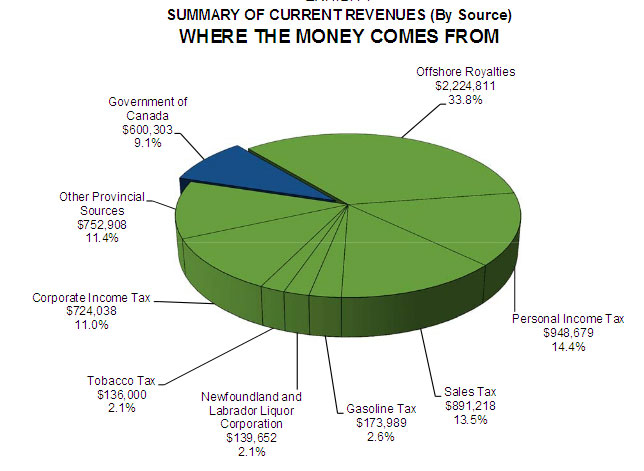
Fiscal Year End Foolishness
The current fiscal year end system demands that everything be spent by March 31, and unspent money is not only "lost" to the department, but can reduce the following years budget because there is a belief that if you don't spend it, you didn't really need it. This demoralizes departments that try to cut costs so that they will have money in reserve for emergencies. Furthermore, the budget is based on arbitrary (because the future oil price guess is arbitrary) anticipated revenues, not on saved cash so there is significant risk of running a deficit.
The end result of this madness is a rash of spending just before March 31 to consume the remaining budget, and no guarantee that anything that was started, a building for example, will even have the funding to be completed.
A well integrated software system for governmental accounting, budget and cost control, SAP for example, would cost about $30M to set up and perhaps 2 years. This would provide budget updates instantly and allow visibility right down to crown corporations. Without such a system, nobody really knows where the money goes. $30M might sound like a lot, but the province has already committed to spend $42 million on the face lift for the confederation building.
Muskrat Falls, which is currently under construction, has been promoted as a future revenue source, however it is quite likely that cost overruns and lower than expected revenues will result in the province losing control of the project to those who financed it. The risk is excessive and the project should be cancelled immediately.
Education (Kindergarten through grade 12)
Teachers salaries represent about 60% of total K-12 costs, the rest is spent on building new schools, upgrading existing schools, paying utility bills, purchasing school books, contracting bus fleets and school board activities. Teachers can't be cut without impacting classroom sizes and the current budget for building maintenance is about half of what it needs to be. There are however, areas that could yield substantial savings.
The province used to have about 600 schools, but due to population decline and consolidation of religious and public school systems, most schools were closed. There are approximately 267 schools in operation in 2013.
There are two schools with 2 children each. In the graph below, the first bucket tells you that there are 20 schools with enrollments between 1 and 20 students. The point of the graph is that there are many schools that currently have very low enrollment. These schools were built for far larger populations in once thriving communities. This trend will continue.
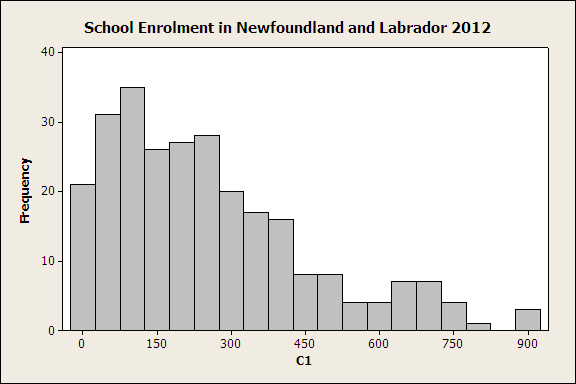
The next chart shows schools by age of building. Buildings are aging just like the population is, many were built when the current adults were children. Most of the buildings built in the 1960's need significant upgrades. The most common problems are heating furnaces that are at end-of-life, roof and window leaks and obsolete electrical systems. Mold problems have been taken care of but there is still more asbestos abatement work to complete. Some schools don't have potable water and have to bring in bottled water because of boil orders. A typical upgrade costs $1 million. A million isn't much -- $100,000 in the 1970's or the price of two new bungalows in St. John's.

Click here for more analysis ...
Full Day Kindergarten
Full day kindergarten should be implemented and has community support as well as support from the NDP. The government explored the options and decided that it was low priorty and abandoned the idea.
No reason was given other than a general statement on television that it was "low priority". The total cost would have been about 130 teaching units and some portable classrooms for a few schools that are currently at full capacity.
Click here for more analysis ...
Higher Education
Memorial University is currently out of control with a massive, highly paid bureaucracy and ever expanding scope. MUN recently purchased the battery hotel, and wants to add a law school.
Aside from massive cuts in the bloated bureaucracy (while keeping the teaching and technical staff), the whole campus model needs re-evaluation. Why would you send a child into St. John's, have them rack up $1000/month in living expenses, just to sit in a large classroom with 100+ other students watching a lecture in math that has not changed since the days of Sir Issac Newton -- when the internet is full of truly excellent lectures and tutorial from other universities and educators?
Outsourcing of Professional Services
Newfoundland and Labrador regularly outsources routine professional services at three times the cost of doing it internally. For example, a senior engineer working for the government makes about $80,000/yr. while the professional engineering fee in the province is approximately $180/hour ($360,000 a year). Similarly, for information technology, rates range from about $60/hr for programming work up to $640/hr for a senior manager from one of the big accounting firms (like Deloitte).
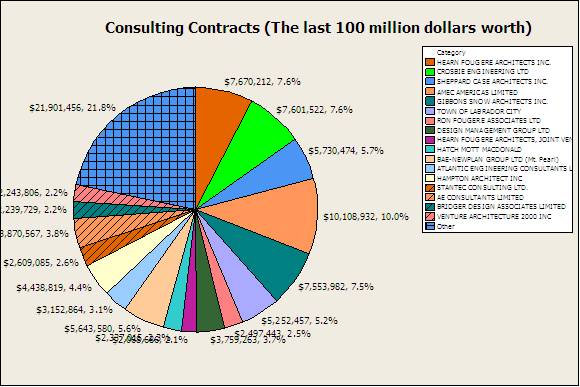
Energy Policy
The province has ample renewable energy.
There is considerable public distrust and skepticism towards the development of the Muskrat Falls hydroelectric project in Labrador. The current plan is to connect it to the island of Newfoundland and on to Nova Scotia. This is a very expensive project estimated to cost 6.2 billion dollars , $7.4 Billion (Oct 2012), $10 Billion (Jan 2013) and therefore it is extremely important to carefully consider all the options. A realistic cost given the rugged terrority, unstable soils and frequent land slides and political pressure to keep the initial estimates low is 10 billion. This project has the potential to double the provincial debt. The spectre of corruption has also been raised, as well as legal issues regarding water rights, the Nova Scotia Link, the federal loan guarantee and the need for a regulatory review.
- The island of Newfoundland does not currently have a electricity shortage
- Population growth has been negative, so demand is unlikely to grow
- There is approximately 850 MW of undeveloped smaller hydro sites on the Island, which could be added incrementally if ever needed
- Wind power has been neglected, and much more capacity can be added
- When the Cornerbrook paper mill finally shuts down, 129 megawatts of Deer Lake power will be avilable on the grid
- Demand reduction via geothermal heating, pellet stoves, improved building insulation and solar heated homes could significantly reduce the need for the provinces only thermal generating station, and perhaps even allow its decommissioning. This option is far the best because it prepares residents for sustainable living and increases disposable income by slashing home heating bills.
- Generation capacity of the upper churchill project could be increased, with full capacity used for peak loading periods that command higher prices, especially since it has the massive Smallwood Resevior to feed it.
more analysis here ... Energy Alternatives for Newfoundland and Labrador
The engineering firm that built the Bay d'Espoir hydroelectric facility was also commissioned to do a complete inventory of Newfoundland's hydro potential. There island potential is a little larger than Muskrat Falls.
Heat pumps are three to four times more efficient than electric baseboard heat, and they work well in Newfoundland. Simply replacing a oil furnace in a public building with electric baseboard heat results in twice as much oil being burnt because the efficiency of generating electricity from the oil fired generator in Holyrood is 32%, while even an old oil furnace is 80% efficient at making heat. Heat pumps in new buildings should be mandatory.
Heat pumps can be used to extract heat from the air, or from ground water in which case they are called geothermal (this is not underground steam like Iceland has). Newfoundland Geothermal
Basing building policies on standards like LEED and Green Globes is largely a waste of time and a form of green washing. For example, getting points towards "Silver" certification for bamboo gym floors (rather than local birch wood that could support local saw mills) or for getting your materials via railway (which the province unfortunately sacrificed in favor of the Trans Canada Highway) is foolish. Instead, Memorial University's engineering department should be working with agencies that construct (Department of Education, Transportation and Works, Housing etc.) to design example buildings that are economical to build and operate and which can be freely copied.
There are many families in St. John's freezing in their unheated homes because they cannot afford to put oil in their tanks. This is unfortunate - we need low cost housing that are as close to solar passive heating as possible (e.g. free to keep warm with perhaps only a sweater need in January/February).
Solar hot water does work, but only when the sun shines. Here is an example in Newfoundland that has been running for three years. Solar Hot Hot Water in Newfoundland.
March 21, 2013: Brad Cabana's article Newfoundland and Labrador's Waterloo - The Lower Churchill is a disturbing read and warrants serious consideration.
Wood Pellets
Wood pellets for heating are underutilized in the province and could reduce demand for oil, electricity and provide local employment. More analysis here ...
Public Building Heating Efficiency
Heating is the largest utility cost for most public buildings and totally dwarfs lighting expenses. High efficiency heating systems, triple glazed windows and eliminating drafts by perhaps replacing the siding and doors are all great improvements, but they don't make economic sense unless certain basic things are taken care of first. It is like buying new energy star appliances to save on the electric bill for a house with a missing back door.Fracking (Hydraulic Fracturing)
Just ban it. The chart below is a list of common fracking fluids that could end up in our drinking water:
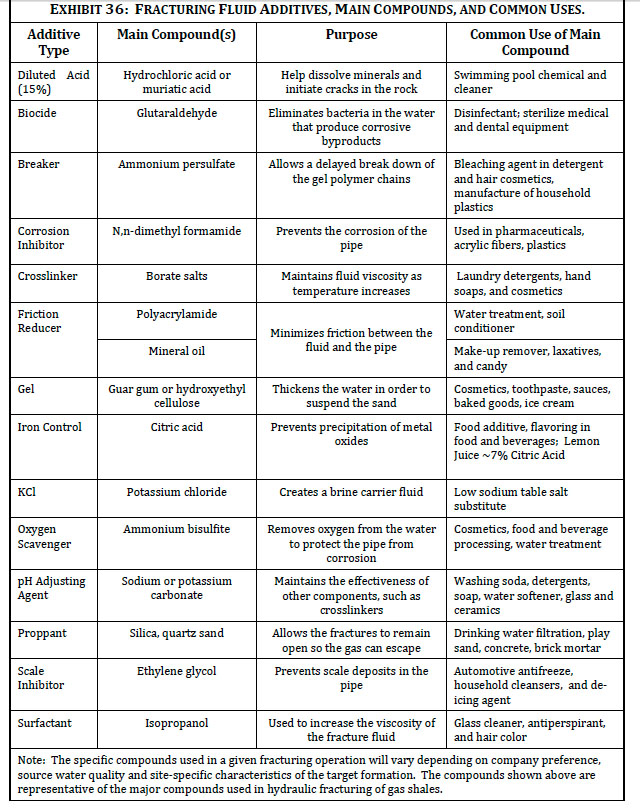
Job Creation
In order for there to be local jobs, goods and services need to be produced in areas that people live. We have exactly the opposite. Consider the following:
- Food: Other than Purity brand biscuits, Mount Scio farm savory, milk, eggs, chicken and a few dozen other items, almost everything in a Dominion or Loblaws store is imported.
- Fuel: Oil for heating and oil used to produce electricity in Holyrood for winter heating is all imported.
- Housing: Virtually all building materials other than perhaps Kento and Acan windows are imported.
- Clothing: Are you wearing anything made in Canada?
- General Stuff: Wallmart has tens of thousands of items for sale -- try to find something local, or even Canadian.
How can you have a population of consumers that produce almost nothing and expect anything other than having it go into debt?
The Economic Recovery Commission (ERC) laid out a plan decades ago to address the problem of employment and made hundreds of recommendations. A wise policy would be to finally adopt them and purge the system that thwarted meaningful change. The book "Against the Tide" should be required reading because it explains the bad actors in the system that thwart progress.
Health Care
This is a complex area that needs a complete overhaul. Health Care also represents the single largest budget item. Education is number two.
Fisheries
It is important that you watch this: Enric Sala: Glimpses of a pristine ocean to understand what has happened to our fishery, and why large codfish have disappeared. This is why we need sewage treatment facilities and fish sanctuaries.
Consider the following dichotomy (extremes):
- A fleet of foreign vessels operating offshore catches the entire North Atlantic quota. It is mechanically processed on-board or sent raw to a country where slave like labor (cruel conditions, no benefits, $1/hour) is available. Nothing is landed on Canada's shores. All profits go to a large corporation. Former fishermen live on unemployment, welfare, or leave the province out of desperation.
- All fish must legally be landed and processed locally. Fish arrive at worker-owned fishing cooperatives and everyone is paid a living wage. Because of hygiene, safety regulations, workers compensation, waste disposal regulations and decent wages, there is minimal corporate profit for middle men and the large corporations have abandoned the fishery. Smaller, locally owned ships catch the fish. Speciality boats are also built locally, and the newer vessels were design by MUN's school of naval architecture.
Which is more efficient? From a corporate perspective, the first option is excellent and serves the shareholders well. For Newfoundland residents, the second option is superior because the wealth is spread around and stays in the province. As for expensive fish -- there is a hungry world out there and quality fish will always be marketable.
This CBC article is worth reading: How neglect of the fishery killed the Salvage fish plant
Increasing and Sustaining Fish Stocks
Permanent fish sanctuaries are needed, strategically located around the province to build up fish stocks. Bottom dragging operations should cease because they destroy important parts of the food chain. The government's role should be to map out where these sanctuaries might go and explain why. Then the fishing community (not large fish companies) should refine the locations, develop a consensus and then collectively enforce them.
Food Fishery should be all year long (with catch limits)
Making criminals of local residents that want to catch a few marine fish for personal consumption is ridiculous. The local population in possession of fishing rods and cod jiggers (and boats) is far too small to make any kind of dent in the marine fish population.
Information Technology
Newfoundland's computer systems used to be managed by a crown corporation called Newfoundland and Labrador Computer Services Limited but it was privatized in 1994. Everything went downhill from there and the province suffered from a decade of neglect.
OCIO was later formed to bring government computing systems back in-house, but by this point, the province was 20 years out of date and far behind the rest of North America - and still is even in 2013.
Many PC workstations are still running Windows XP and Office 2003 and Microsoft update is disabled. If the updating is enabled, there are literally dozens of critical security patches to apply which means that most of the provinces computers are easy targets for hackers and viruses.
Some government workers have had products like Microsoft Access (a program for managing data and lists) removed from their computers by OCIO, and writing visual basic scripts in Excel (a spreadsheet program) is forbidden. Attempting to obtain software needed to perform basic job functions that would be automatic in most companies is often a futile exercise in paperwork.
Larger accounting systems are also pathetic -- employees can't enter their working hours on line and budget control is primitive. The province of Nova Scotia is far ahead of Newfoundland.
Action Items:
- Allow departments to manage their own computer applications. Allow public workers to use products like MS Project, Acrobat Professional, MS Access as well as open source software to do their jobs. Currently OCIO is an impediment to government operations.
- Update all personal computers immediately with the latest security patches. It is time to get rid of Windows XP since it will soon be abandoned.
- Implement a government wide accounting system. I would dump Oracle Financials and go with SAP, modelling it after Nova Scotia (The federal government uses SAP also). However, this must be done in house - NOT tendered to large accounting / consulting firms for tens of millions. Sorry Aliant/Deloitte/Accenture :(
- Ensure that there is a province wide backbone for video conferencing that can be used to eliminate the need for government business travel and support remote schools (lectures) and medical clinics (distance medicine) with high definition video conferencing.
The following presentation was prepared for ex Premier Danny Williams, and is still valid today. It gives an overview of integrated accounting systems that support planning and eliminate budget defect surprises.
IT Strategy Newfoundland (slide presentation)
Internet Access and Rural Coverage
Communities that depend on telephone dial-up for internet access and/or have no cell phone coverage are at a significant disadvantage in attracting businesses and retaining youth. Online banking, access to training materials and on-line coursework, web-mail, social networking and entertainment are now considered essential by young people.
Secrecy and Bill 29
There is no place for governmental secrecy in democracy, yet according to this article, we rank behind Ethiopia, Guatemala and Uganda.
Governmental Spying and the NSA
Canada spys on its citizens and trades data with the NSA. The Newfoundland government is silent on the issue.
Population Growth
Growth of any kind is not sustainable. The famous lectures from Dr. Albert Bartlett make this point quite well.
Much of our economic strategy assumes exponential growth (compound interest on retirement savings) which is just insane. Compound Interest
Given that the province isn't growing, is the current population sustainable? Newfoundland's Carrying Capacity
This may all be a blessing in disguise. However, the ratio of old to young people though is a problem. This is best addressed by a move towards worker owned cooperative enterprises similar to the Mondragon Cooperatives of the Basques region of Spain. Most young people leave because they need a job. That must be fixed immediately.
Climate Change, Energy Efficiency, Emissions Trading
These are included together just because there is currently a department by that name. It should be eliminated for an annual savings of one million dollars.
We can contribute to climate change by improving building code so that we use less heat and reduce the need for the oil fired Holyrood generator. Simple building code improvements (more insulation, properly installed windows) do not need an independent department. Worring about efficiency when there are hundreds of public buildings in the province that don't have any insulation under the floors is like worrying about which brand of low flow shower head to buy while ignoring a garden hose that has been running 24 hours a day for 30 years.
Emissions Trading is an immoral farce and shouldn't exist.
Risk Management
There are many things governments do because it sounds good and might buy votes. Consider these rhetorical questions:
Would you spend $2,000,000 to stop something that might save one life in the province every 200 years or possibly never ?
Would you life in fear about something that is less likely then being struck twice by lightening?
Consider this quote from a risk management course: "Some 30% homes in northern New Jersey have enough radon seeping into their basements to pose more than 1/100 life-time risk of lung cancer but despite considerable media attention only 5 home owners arranged to monitor their homes and level of distress is very modest (source of radon is geological uranium). A landfill with very low level radioactive industrial waste created an outrage and fear in the community. As a result public demanded hundreds of thousands of dollars per home to clean up the landfill."
Things that are involuntary and uncontrollable, like a school shooting are seen as riskier than voluntary things like driving and hitting a moose - reality be damned.
The solution is simple. Publish a list of risks based on historical statistics, sorted from most likely to the remote. These would include general traffic fatalities, fatal moose-vehicle collusions would be much higher on the list than school shootings. Each risk would then have a list of potential solutions, their costs and the expected results.
The electorate then needs to be aware that the further down the list you go, the higher the taxes required to pay for it all. It is hard to say no thanks to "safe and caring schools" without sounding callous, but when faced with spending $2,000,000 on prison features in schools for an exceedingly unlikely event that has never happened before, rather than spending half that on vaccines that regularly save lives - the choice becomes obvious.
Daylight Savings Time
Most of the world doesn't bother with such foolishness. Why adjust millions of appliances, thermostats and computer systems plus disturb sleep pattern twice a year - especially when our time zone isn't synchronized with any other jurisdiction? The map below is from wikipedia. Unnecessary and useless procedures should be eliminated.
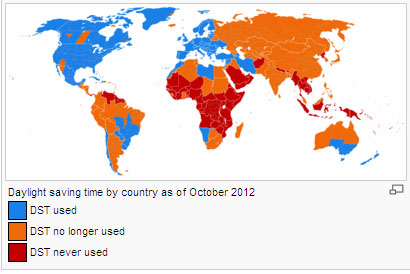
Voting
Our present voting system is the worst possible system. It can be vastly improved with one simple change: allow voters to check off all candidates that are acceptable.
Click here for an entertaining analysis: Voting Methods
Add a box for "None are acceptable" because there comes a time when voting for the lesser of the evils, is just voting for evil. If "None of the above" wins, all the candidates should be disqualified and a new election held with a new field of candidates.
Moose Accidents
The province has several hundred moose - vehicle accidents a year on the Island. The probability of being involved in an accident is therefore at least 800/513,000 = 16,000 in a million. The chance of getting murdered this year is about 5/513,000 or 2.5 in a million.
From the article Vehicle-Moose Accidents in Newfoundland "During 1987 and 1988, in Newfoundland, there were 661 motor-vehicle accidents involving a moose; 133 people were injured and three died. This constitutes a major problem for the provincial healthcare system."
The Cost of Things (Infrastructure Projects)
It is worthwhile taking a look at some projects so that things can be put in perspective.
Here are the most expensive projects in recent years with the cost in millions.
| Project Description | Cost |
|---|---|
| Carbonear Long Term Care Project | 73M |
| John's Long Term Care, West Patient Tower | 68M |
| Labrador West Health Care Facility | 56M |
| St. John's Long Term Care - East Patient Tower | 53M |
| Design-Build Contract,Corner Brook Long Term Care Facility | 50M |
| Building Envelope Upgrading East Block, Confederation Building | 41M |
| Construction of a new vertical lift bridge | 40M |
| Main Building Contract, The Rooms, St. John's | 34M |
| Redevelopment of RNC Campus | 31M |
| New K-6 Schools for Torbay and Paradise | 28M |
| Summer and Winter Maintenance on 570 km of Roads and Bridges on R510, Labrador | 22M |
Note that most of the large projects are health care related. Roads cost about 1/4 million per kilometer to grind and surface. The Building exterior upgrade for the Confederation building is worth a look -- drive around the back of the building and see for yourself what $41 million gets you. The Tory blue panels are new, the turquoise panels are the original. Perhaps, but the time it is finished, the remaining panels will be red or yellow.
Highway Construction
Highway construction and maintenance is a large part of the provincial budget. Everyone wants divided four lane highways and paved secondary roads - paying for it is another matter entirely.
Annual road budgets have been running approximately $150 million a year. According to Statistics Canada there are 184,325 wage earners in the province. Therefore, road construction is costing $800/year per wage earner, and that doesn't include snow clearing, sand and salt.
In 2012, $108 million was awarded for highway construction and $38 million of this was for two projects in Labrador. These two road sections cost $38M/158 km = $240,000 per kilometer.
- Paving of the Trans Labrador Highway from km 172.5 to km 248.5, Goose Bay towards Churchill Falls
- Paving of the Trans Labrador Highway between km 196 and km 278, Wabush Junction towards Churchill Falls
It is worth browsing the last three years of road contracts to get a feel for the relative costs of projects.
Better Employment Models
Employee owned cooperatives modelled after the Mondragon cooperatives that were developed in the Basque region of Spain would work well in Newfoundland.
Pensions
This is a thoroughly depressing topic with no easy solution - skip it if you aren't in the mood. If you watch the Albert Bartlett lectures you will understand why perpetual, compounding growth is impossible. Pensions are all based on the idea that the small contributions made during the working years will grow large enough to cover us for old age. Have a look at the insanity of compound interest.
Current interest rates are close to zero. If you plan on living to the age of 90 and retiring at age 65, then you are also expecting a nest egg large enough for 25 years of living expenses. This would require you saving half your take home pay for your entire working life. If the population was still growing, younger workers could fund retirees -- however, even this would be a Ponzi scheme doom to fail later on.
It gets worse because of money printing and devaluating currencies. The euphemism for this is quantitative easing, sometimes abbreviated QE. Those that are ready to retire now remember what a dollar bought them in 1970 (a chocolate bar was a dime, gas was 30 cents a gallon, eggs were 30 cents). Over this period, the decimal point moved. By the time a new retiree is 90, todays pensions will be useless unless indexed for inflation.
Assuming that we don't have an worldwide meltdown, the following need to be implemented now:
- Much larger contributions
- Increased retirement age (perhaps 71 which is 10 years less than the average lifespan of 81)
- Fixed payouts indexed for real inflation (not some bogus pretend inflation rate)
- Monies must be kept safe in something tangible (land, gold, silver, small hydroelectric plants, Newfie Screech)
- Pensions must be government backed. Private companies want nothing to do with defined benefit plans.
Assuming a worldwide meltdown (unfortunately not that far fetched)
- Own your house and land free and clear
- Live as an extended family. The young look after the older generation and inherit their estate.
